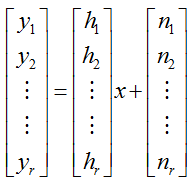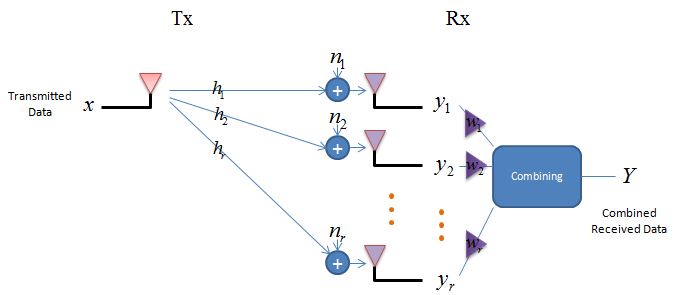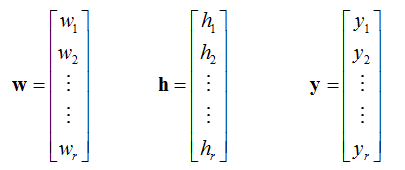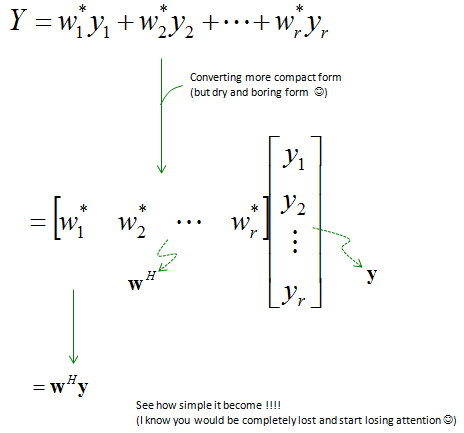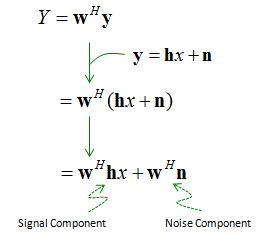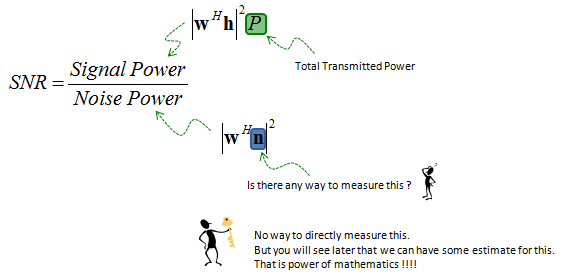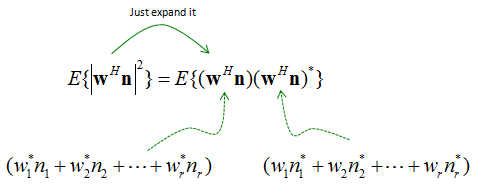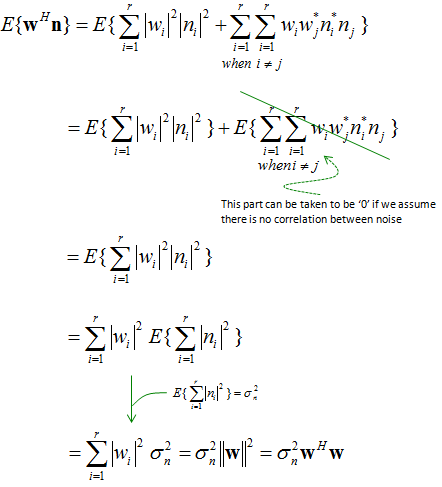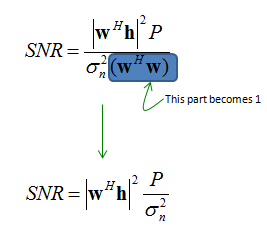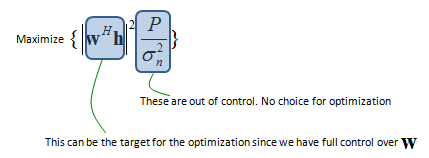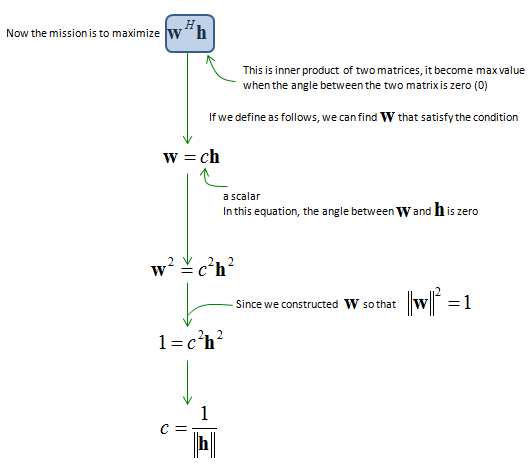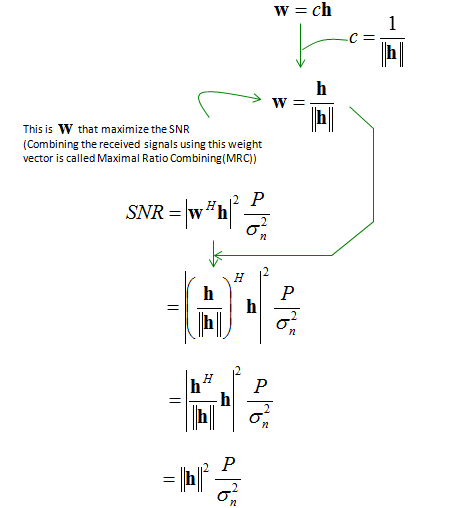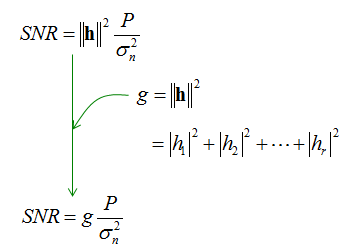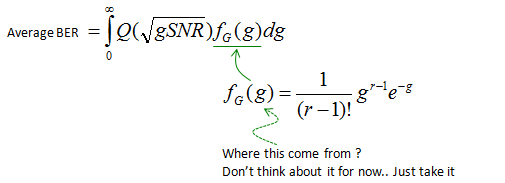|
Communication Technology |
||
|
Rx Diversity
From the generalized r-by-t configuration you can derive a lot of special cases. For example, it you set t = 1, you can create a diversity situation as follows.
With just a little bit of modification, you can create more realistic diversity case as shown below. This model and mathematical description is largely based on Mod-01 Lec-06 Multi-antenna Maximal Ratio Combiner by Prof. Aditya K. Jagannatham, Department of Electronics & Communication Engineering, IIT Kanpur. I like this lecture very much and take it as my best reference. You can search this lecture from YouTube (I didn't put the hyper link since the link tend to change. I suggest you to search by lecture title).
First let's make a list of vectors which are used to describe this model. It is the first step to get familiar with mathmatical description of channel model. Note that all the vectors are defined as a column vector.
First, let's see how to describe the total (combined) signal. It is described as follows. I draw the illustration above just based on this equation (The first line)
If you plug in the equation that describes the signal received by each antenna including the noise factors, you would have the following equation.
Now you have the equation for the total received (combined) signal which includes all the factors, i.e, weighting factor, channel coefficients and noise. This can be the starting point for derivation of all other factors.
What we need to do eventually is to figure out w (weight vector) that produces the best quality of Y. The 'best quality of Y' means 'Y that gies the highest SNR'. It mean that we need to derive another equation to figure out SNR (the boring math keep going -:)
Let's start deriving SNR. The definition of SNR is the ratio of Signal Power and Noise Power as you know. For the model in this example, it can be described as follows. (NOTE : in the following equation, you would notice that 'x' is gone. Where did it go ? For SNR calculation, the transmitted symbol value is not important.. the important thing is the power of 'x'. The power of x is expressed as 'P')
Signal Power part may be straightfoward since all the parameters can be explicitely obtained by channel estimation process or some predefined values, but Noise Power part is not the one that can be explictely measured. So for this one, we need to estimate this term using a statistical method. For this statistical estimation, we assume the important things as follows. (NOTE : If there is a situation which does not match this assumption, the methmatical model for the situation would be very complicated. You might have seen some papers for the case that does not apply these assumptions). i) There is no correlation among each of the noise terms. => this mean that E{n1 n2 ... nr} = 0 ii) Each noise terms take Gaussian distribution. => this mean that E{n1^2 + n2^2 +...+ni^2} = sigma^2
Now let's start a long process of deriving the noise factors. First, figure out the statistical expectation of the noise factors and expand it into terms representing each path of the antenna configuration. It can be represented as shown below.
If r is small number like 2, you can directly calculate this terms as you learned in high school math, but if r is larger number, it may be too complicated and tedius to directly solve it. You can describe this term (multiplications of two long equations) as follows. It may take some time and effort for you to understand how this form gets derived, but once you understand it (or just follow it), you can easily calculate these multiplication however long they are.
With the expression above, you can rewrite the expectation of noise term as shown below. It is a long process, but you will get very compact form at the end of this process.
If you rewrite the whole SNR equation using the compact form you get above, you would get the final form of SNR as shown below.
Now we have a question. The best condition in the reciever side is the condition where SNR gets maximum. Can we find such a condition. Following is the procedure to find such a condition.
The SNR formula derived above is a generic case. Now let's try simplifying this a little bit. This kind of simplification is not only for mathematical simplicity, but also has advantage in terms of implementation.
Let's suppose we can arbitraly set the vector 'w' in such a way that the maginitue (norm) is became 1. (Of course, this is possible even in reality because this is something we can decide in Reciever baseband algorithm). Then the inner product of the vector and Hermitian of the vector become 1 as shown below.
Plugging this result into the SNR formula we derived above, it became simpler as shown below.
With this simplified equation, let's take one step further. Now, we are trying to maximize the SNR. Why do we want to maximize SNR ? As you know from the basic theory, high SNR means better condition for decoding the received signal and it lead to less BER (Bit Error Rate).
Now the question becomes how to maximize the following mathemtical expression (i.e, SNR). In any mathematical optimization, the first step to maximize (or minimize) is to remove what don't have any control. Any constant component in the mathematical expression is out of scope of the optimization because they are already fixed and we cannot change those values.
If we remove the constant part as indicated above, our target for optimization becomes as shown below. As shown below, we optimize this part by tweaking the vector w, not the vector 'h'. Why ? It is because we also do not have much control over the vector 'h'. The vector 'h' is a kind of variable (not a constant) but this variable cannot be changed as we like since it is determined by 'Channel Condition'. It is determined by 'Nature', not by us. I think you can understand the approach on how we optimize this portion just by following through the sequence as described below. (Basically this process is to use the property of Inner Product. If you haven't learned anything about high school math for vector/matrix or Linear Algebra in the university, you may need to study a little bit of that part first.)
By plugging what we got above into the original SNR equation and go through a couple of further simplification step we can get the very simple equation that can maximize SNR as show below.
Estimation of BER
Once you have the SNR for the condition that you want to achieve, you can derive (estimate) BER (Bit Error Rate) from SNR with the following procedure.
In practice, SNR is very important because it directly influence signal decoding capability and in theory (also in practice as well) it is also imporant since it can be used to derive many other parameters in communication. For example, SNR becomes the basis to estimate BER (Bit Error Rate). (Actually, BER (or BLER) becomes the major criteria for CQI value in many communication system, e.g, WCDMA, LTE. So we can say "SNR is critical factor to determine CQI value in those system").
In this specific case (Maximal Ratio Combining Diversity) case, BER can be calculated as shown below. But you don't have to focus too much about the detailed mathematics here.. I just recommend you to realize that SNR is critical part to determine BER and overall relationship between SNR and BER. Probably Bit Error / Bit Error Rate (BER) page would give you more intuitive understanding.
|
||
